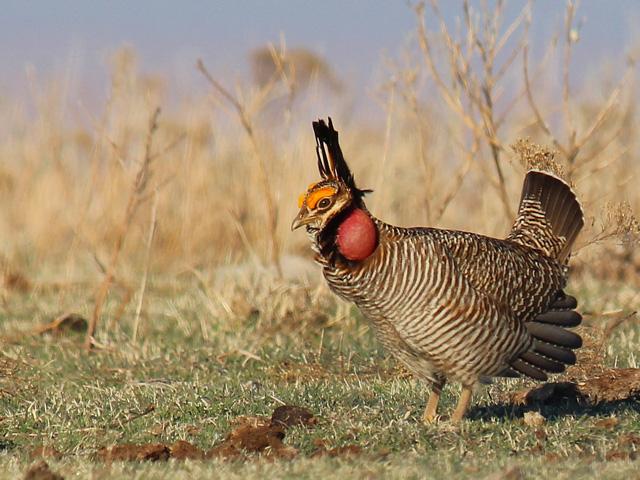Ag Policy Blog
State AGs Lining up to Sue Over Lesser Prairie Chicken Listing
State attorneys general for Kansas, Oklahoma and Texas have now each filed notice that they intend to sue the U.S. Fish and Wildlife Service and Department of Interior over the latest push to list lesser prairie chicken as endangered or threatened under the Endangered Species Act.
Texas Attorney General Ken Paxton announced he has filed a Notice of Intent with the Biden administration, following similar actions last week by the AGs in Kansas and Oklahoma.
The lesser prairie chicken is a grouse that makes its home in parts of Colorado, Kansas, New Mexico, Oklahoma and Texas. The five-state area range for the lesser prairie chicken is about 21 million acres, but roughly 4 million of those acres are considered habitat for the bird.
The U.S. Fish and Wildlife Service submitted its rule Nov. 25 seeking to define the lesser prairie chicken as "threatened" in northern areas that include eastern Colorado, western Kansas, western Oklahoma and a few counties in the Texas Panhandle.
The southern population of the bird, in a few western Texas counties and eastern New Mexico in an area roughly between Roswell, N.M., and Lubbock, Texas. The FWS notice would southern population of the lesser prairie chicken as endangered. The southern area would come with a "4(d)" rule under the Endangered Species Act, adding more specific protective measures for the lesser prairie chicken.
FWS, in its rule, notes that lesser prairie chicken population in the late 1960s was estimated at about 175,000 males. That population fell as low as 25,000 males in 1997. The population rallied to a high of about 92,000 males in 2006, but then the population again declined to 34,400 males in 2012. Over the last five years, population was estimated at 32,200.
The biggest requirement for lesser prairie chicken populations is "large, intact, ecologically diverse grasslands," FWS stated.
The primary risk for the lesser prairie chicken is habitat loss and land fragmentation, FWS stated. Some of the impacts include loss of rangeland converted to cropland – about 4.9 million acres -- and encroachment from woody vegetation such as mesquite and eastern red cedar. Other impacts stem from development of rads, petroleum production, wind energy, and transmission lines. Wildfires and other extreme weather events are also impacting lesser prairie chickens and their habitat as well.
P[L1] D[0x0] M[300x250] OOP[F] ADUNIT[] T[]
The vast majority of lesser prairie chicken range also occurs on private lands that have been in some form of agricultural production for more than a century.
Under the rule, cattle producers or other livestock for grazing in the affected areas would have to create site-specific grazing plans that have been developed by a third party that has been approved by U.S. Fish and Wildlife.
The original FWS rule was set to go into effect Jan. 24, but after an extension the final rule is now set to go into effect March 27.
Texas' Paxton, in a news release Monday, stated the actions by FWS and the Department of Interior would "significantly affect the quality of the human environment," which requires and impact analysis under the National Environmental Policy Act (NEPA).
"These federal requirements were not met in this case. Additionally, the new rule puts at risk the considerable conservation efforts that the State of Texas, other states, industry groups, private landowners, and conservation organizations have already implemented to protect LPCs (lesser prairie chickens)."
Paxton described the rule as another example of the Biden administration's "willingness to prioritize executive overreach over state-directed management and conservation of wildlife and natural resources," the AG's news release stated.
"I will not tolerate the Biden Administration's efforts to run roughshod over the property rights of Texans and to stop our conservation efforts aimed at protecting Texas wildlife," said Attorney General Paxton. "This rule was a targeted attempt to implement an unlawful, top-down federal approach aimed at advancing a radical environmentalist agenda, which would crush the type of economic development that aids in providing funds for conservation. This isn't going to fly in Texas."
Oklahoma AG Gentner Drummond also cites that the final rule "fails to adequately consider the existing conservation programs that the state of Oklahoma as implemented in cooperation with other stakeholders." The new rule also fails to take into account the best scientific and commercial data available, Drummond stated.
"This rule presents an existential threat for cattle grazing, energy production, and other vital aspects of Western Oklahoma's economy," Drummond said.
Kris Kobach, the Kansas attorney general, stated the rule change would require Kansas ranchers to seek the federal government's permission to move cattle to a new field. It would also create tougher restrictions for energy pipelines, roads and other development, including oil drilling, he stated.
"The Biden administration's listing of this species will have a devastating impact on Kansas ranchers, Kansas oil producers, and Kansas wind farms. Moreover, it is illegal. Kansas will lead the way in fighting against this overreach by the Biden administration."
Kobach's Notice of Intent to sue https://ag.ks.gov/…
Federal Register: FWS rule on the lesser prairie chicken https://www.federalregister.gov/…
Chris Clayton can be reached at Chris.Clayton@dtn.com
Follow him on Twitter @ChrisClaytonDTN
(c) Copyright 2023 DTN, LLC. All rights reserved.





Comments
To comment, please Log In or Join our Community .